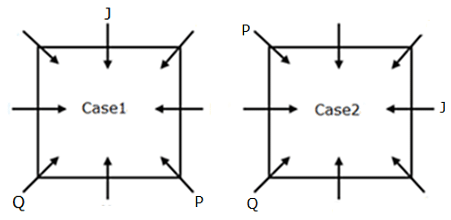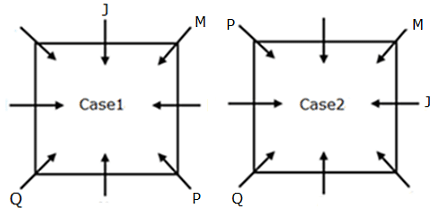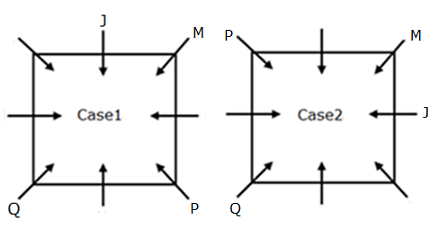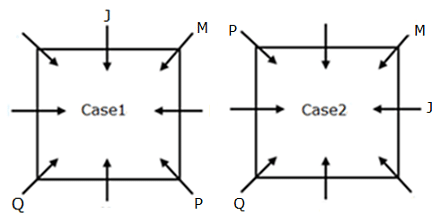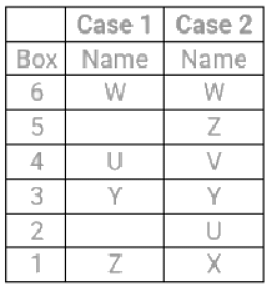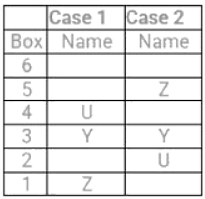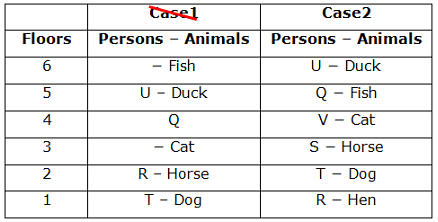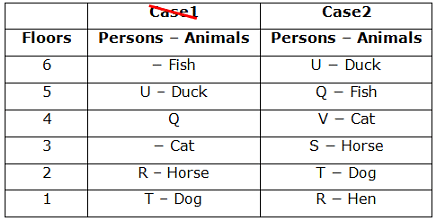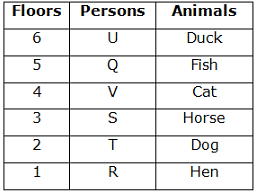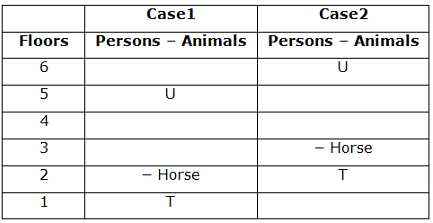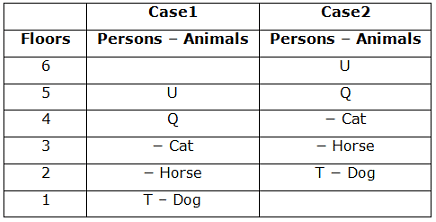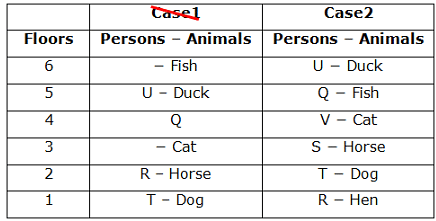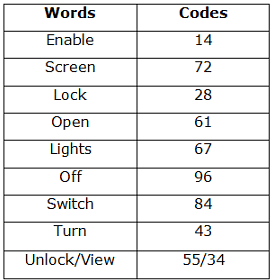IBPS RRB PO (Scale 1) Prelims Mock Test - 7 - Banking Exams MCQ
30 Questions MCQ Test - IBPS RRB PO (Scale 1) Prelims Mock Test - 7
Study the following information carefully and answer the questions given below.
Eight persons - J, K, L, M, N, O, P and Q are sitting around a square table facing towards the centre of the table, but not necessarily in the same order. Four persons sit on the corners and four persons sit on the middle of the sides of the table.
Two persons sit between J and Q, who doesn’t sit on the middle of the sides of the table. J sits adjacent to the one who faces P. Five persons sit between P and M. The number of persons sitting between M and N is the same as the number of persons sitting between N and O. K sits third to the left of O.
Who among the following person sits facing towards O?
Study the following information carefully and answer the questions given below.
Eight persons - J, K, L, M, N, O, P and Q are sitting around a square table facing towards the centre of the table, but not necessarily in the same order. Four persons sit on the corners and four persons sit on the middle of the sides of the table.
Two persons sit between J and Q, who doesn’t sit on the middle of the sides of the table. J sits adjacent to the one who faces P. Five persons sit between P and M. The number of persons sitting between M and N is the same as the number of persons sitting between N and O. K sits third to the left of O.
Four of the following five are alike in a certain way as per the given arrangement and hence form a group. Find the one who doesn’t belong to that group.
| 1 Crore+ students have signed up on EduRev. Have you? Download the App |
Study the following information carefully and answer the questions given below.
Eight persons - J, K, L, M, N, O, P and Q are sitting around a square table facing towards the centre of the table, but not necessarily in the same order. Four persons sit on the corners and four persons sit on the middle of the sides of the table.
Two persons sit between J and Q, who doesn’t sit on the middle of the sides of the table. J sits adjacent to the one who faces P. Five persons sit between P and M. The number of persons sitting between M and N is the same as the number of persons sitting between N and O. K sits third to the left of O.
Who among the following person sits second to the left of N?
Study the following information carefully and answer the questions given below.
Eight persons - J, K, L, M, N, O, P and Q are sitting around a square table facing towards the centre of the table, but not necessarily in the same order. Four persons sit on the corners and four persons sit on the middle of the sides of the table.
Two persons sit between J and Q, who doesn’t sit on the middle of the sides of the table. J sits adjacent to the one who faces P. Five persons sit between P and M. The number of persons sitting between M and N is the same as the number of persons sitting between N and O. K sits
third to the left of O.
How many persons sit between O and Q, when counted from the right of O?
Study the following information carefully and answer the questions given below.
Eight persons - J, K, L, M, N, O, P and Q are sitting around a square table facing towards the centre of the table, but not necessarily in the same order. Four persons sit on the corners and four persons sit on the middle of the sides of the table.
Two persons sit between J and Q, who doesn’t sit on the middle of the sides of the table. J sits adjacent to the one who faces P. Five persons sit between P and M. The number of persons sitting between M and N is the same as the number of persons sitting between N and O. K sits third to the left of O.
Who among the following person sits facing towards O?
Direction: The following questions are based on the three-digit numbers given below. Study the information carefully and answer the questions.
713 486 635 562 875
If each number second and third digits are interchanged, then how many odd numbers are there?
Direction: The following questions are based on the three-digit numbers given below. Study the information carefully and answer the questions.
713 486 635 562 875
If the second and third digits of each of the numbers are added then the resulting sum of these two digits are divisible by 3 for which of the following number?
Study the following information carefully and answer the questions given below.
A family consist of three married couples. P is the daughter-in-law of K. S is the brother-in-law of O, who is the father of T. O doesn’t have any siblings. R is the only sister of V and the mother of S. V is the maternal uncle of P. J is the father-in-law of P. T is the granddaughter of Q. No single parent has a child.
If V is married to W, then how is W related to R?
Study the following information carefully and answer the questions given below.
A family consist of three married couples. P is the daughter-in-law of K. S is the brother-in-law of O, who is the father of T. O doesn’t have any siblings. R is the only sister of V and the mother of S. V is the maternal uncle of P. J is the father-in-law of P. T is the granddaughter of Q. No single parent has a child.
How many female persons are there in the family?
Study the following information carefully and answer the questions given below.
A family consist of three married couples. P is the daughter-in-law of K. S is the brother-in-law of O, who is the father of T. O doesn’t have any siblings. R is the only sister of V and the mother of S. V is the maternal uncle of P. J is the father-in-law of P. T is the granddaughter of Q. No single parent has a child.
Who among the following person is the niece of V?
Direction: Study the following information carefully and answer the question given below.
Six boxes viz. U, V, W, X, Y and Z were placed one above the other in the single stack, but not necessarily in the same order. The lowermost box is numbered 1 and the box immediately above is numbered 2 and so on.
Y was placed at box 3. U was placed adjacent to Y. Two boxes were placed between U and Z. W was placed at the top. Only one box was placed between W and V.
In which of the following position does Z was placed?
Direction: Study the following information carefully and answer the question given below.
Six boxes viz. U, V, W, X, Y and Z were placed one above the other in the single stack, but not necessarily in the same order. The lowermost box is numbered 1 and the box immediately above is numbered 2 and so on.
Y was placed at box 3. U was placed adjacent to Y. Two boxes were placed between U and Z. W was placed at the top. Only one box was placed between W and V
How many boxes are there between U and Z?
Direction: Study the following information carefully and answer the question given below.
Six boxes viz. U, V, W, X, Y and Z were placed one above the other in the single stack, but not necessarily in the same order. The lowermost box is numbered 1 and the box immediately above is numbered 2 and so on.
Y was placed at box 3. U was placed adjacent to Y. Two boxes were placed between U and Z. W was placed at the top. Only one box was placed between W and V.
Which of the following box was placed at box 4?
Direction: Study the following information carefully and answer the question given below.
Six boxes viz. U, V, W, X, Y and Z were placed one above the other in the single stack, but not necessarily in the same order. The lowermost box is numbered 1 and the box immediately above is numbered 2 and so on.
Y was placed at box 3. U was placed adjacent to Y. Two boxes were placed between U and Z. W was placed at the top. Only one box was placed between W and V.
How many boxes are there between W and Z?
Direction: Study the following information carefully and answer the question given below.
Six boxes viz. U, V, W, X, Y and Z were placed one above the other in the single stack, but not necessarily in the same order. The lowermost box is numbered 1 and the box immediately above is numbered 2 and so on.
Y was placed at box 3. U was placed adjacent to Y. Two boxes were placed between U and Z. W was placed at the top. Only one box was placed between W and V.
Which of the following box was placed at box 2?
Study the following information carefully and answer the questions given below.
Six persons - Q, R, S, T, U and V are living in a six-storey building, but not necessarily in the same order. They like different animals - Dog, Hen, Horse, Cat, Duck and Fish. The lower-most floor is numbered as 1 and the floor immediately above is numbered as 2 and so on.
Only two persons live between the one who likes horse and U, who lives above the third floor. T lives immediately below the one who likes horse. The one who likes cat lives two floors above T. Q lives three floors above the one who likes dog. Q doesn’t like cat. No one lives between the one who likes duck and fish. Only three persons live between R and the one who likes fish. The one, who likes dog, lives on the adjacent floor of S.
Find the odd one out.
Study the following information carefully and answer the questions given below.
Six persons - Q, R, S, T, U and V are living in a six-storey building, but not necessarily in the same order. They like different animals - Dog, Hen, Horse, Cat, Duck and Fish. The lower-most floor is numbered as 1 and the floor immediately above is numbered as 2 and so on.
Only two persons live between the one who likes horse and U, who lives above the third floor. T lives immediately below the one who likes horse. The one who likes cat lives two floors above T. Q lives three floors above the one who likes dog. Q doesn’t like cat. No one lives between the one who likes duck and fish. Only three persons live between R and the one who likes fish. The one, who likes dog, lives on the adjacent floor of S.
Who among the following person lives immediately above the one who likes hen?
Study the following information carefully and answer the questions given below.
Six persons - Q, R, S, T, U and V are living in a six-storey building, but not necessarily in the same order. They like different animals - Dog, Hen, Horse, Cat, Duck and Fish. The lower-most floor is numbered as 1 and the floor immediately above is numbered as 2 and so on.
Only two persons live between the one who likes horse and U, who lives above the third floor. T lives immediately below the one who likes horse. The one who likes cat lives two floors above T. Q lives three floors above the one who likes dog. Q doesn’t like cat. No one lives between the one who likes duck and fish. Only three persons live between R and the one who likes fish. The one, who likes dog, lives on the adjacent floor of S.
S lives on which of the following floor?
Study the following information carefully and answer the questions given below.
Six persons - Q, R, S, T, U and V are living in a six-storey building, but not necessarily in the same order. They like different animals - Dog, Hen, Horse, Cat, Duck and Fish. The lower-most floor is numbered as 1 and the floor immediately above is numbered as 2 and so on.
Only two persons live between the one who likes horse and U, who lives above the third floor. T lives immediately below the one who likes horse. The one who likes cat lives two floors above T. Q lives three floors above the one who likes dog. Q doesn’t like cat. No one lives between the one who likes duck and fish. Only three persons live between R and the one who likes fish. The one, who likes dog, lives on the adjacent floor of S.
How many persons live between Q and the one who likes hen?
Study the following information carefully and answer the questions given below.
Six persons - Q, R, S, T, U and V are living in a six-storey building, but not necessarily in the same order. They like different animals - Dog, Hen, Horse, Cat, Duck and Fish. The lower-most floor is numbered as 1 and the floor immediately above is numbered as 2 and so on.
Only two persons live between the one who likes horse and U, who lives above the third floor. T lives immediately below the one who likes horse. The one who likes cat lives two floors above T. Q lives three floors above the one who likes dog. Q doesn’t like cat. No one lives between the one who likes duck and fish. Only three persons live between R and the one who likes fish. The one, who likes dog, lives on the adjacent floor of S.
S lives on which of the following floor?
Study the following information carefully and answer the questions given below.
Six persons - Q, R, S, T, U and V are living in a six-storey building, but not necessarily in the same order. They like different animals - Dog, Hen, Horse, Cat, Duck and Fish. The lower-most floor is numbered as 1 and the floor immediately above is numbered as 2 and so on.
Only two persons live between the one who likes horse and U, who lives above the third floor. T lives immediately below the one who likes horse. The one who likes cat lives two floors above T. Q lives three floors above the one who likes dog. Q doesn’t like cat. No one lives between the one who likes duck and fish. Only three persons live between R and the one who likes fish. The one, who likes dog, lives on the adjacent floor of S.
How many persons live between Q and the one who likes hen?
Study the following information carefully and answer the questions given below.
Six persons - Q, R, S, T, U and V are living in a six-storey building, but not necessarily in the same order. They like different animals - Dog, Hen, Horse, Cat, Duck and Fish. The lower-most floor is numbered as 1 and the floor immediately above is numbered as 2 and so on.
Only two persons live between the one who likes horse and U, who lives above the third floor. T lives immediately below the one who likes horse. The one who likes cat lives two floors above T. Q lives three floors above the one who likes dog. Q doesn’t like cat. No one lives between the
one who likes duck and fish. Only three persons live between R and the one who likes fish. The one, who likes dog, lives on the adjacent floor of S.
Who among the following person likes cat?
M is greater than R in age. Q is greater than R and N. N is not as tall as M. who is the eldest among M, N, R and Q?
Study the following information carefully and answer the questions given below.
In a certain code language,
‘Lock Screen Enable Open’ is coded as ‘72 28 14 61’
‘Enable Switch Lights Off’ is coded as ‘96 14 84 67’
‘Screen Lights Turn Enable’ is coded as ‘43 67 72 14’
‘Open Unlock Off View’ is coded as ‘55 96 34 61’
If the code for “Unlock Power” is “34 89”, then what is the code for the phrase “View Turn Power” in the given code language?
Study the following information carefully and answer the questions given below.
In a certain code language,
‘Lock Screen Enable Open’ is coded as ‘72 28 14 61’
‘Enable Switch Lights Off’ is coded as ‘96 14 84 67’
‘Screen Lights Turn Enable’ is coded as ‘43 67 72 14’
‘Open Unlock Off View’ is coded as ‘55 96 34 61’
What does the code “96 55” represent in the given code language?
Study the following information carefully and answer the questions given below.
In a certain code language,
‘Lock Screen Enable Open’ is coded as ‘72 28 14 61’
‘Enable Switch Lights Off’ is coded as ‘96 14 84 67’
‘Screen Lights Turn Enable’ is coded as ‘43 67 72 14’
‘Open Unlock Off View’ is coded as ‘55 96 34 61’
What is the difference between the codes for the words “Lights” and “Open” in the given code language?
Study the following information carefully and answer the questions given below.
In a certain code language,
‘Lock Screen Enable Open’ is coded as ‘72 28 14 61’
‘Enable Switch Lights Off’ is coded as ‘96 14 84 67’
‘Screen Lights Turn Enable’ is coded as ‘43 67 72 14’
‘Open Unlock Off View’ is coded as ‘55 96 34 61’
What does the code “28 14 61” represent in the given code language?
Direction: In the question below are given two statements followed by two conclusions numbered I and II. You have to take the given statements to be true even if they seem to be at variance with commonly known facts. Read all the conclusions and then decide which of the given conclusions logically follows from the given statements disregarding commonly known facts.
Statement:
Some Table is Chair.
All Chair are Furniture.
Conclusion:
I. Some Table is Furniture.
II. All furniture is Table.
Study the following information carefully and answer the questions given below.
Six persons - J, K, L, M, N, and O are getting different salaries. J gets more salary than O, who does not get the lowest salary. Only two persons get more salary than M. K gets more salary than O but less than M. The one who gets the second lowest salary gets Rs.3000, which is one-third of the salary of N. The salary of J is three times the salary of L.
If the sum of the salaries of N and M is Rs.15000, then what may be the difference between the salaries of M and O?
Study the following information carefully and answer the questions given below.
Six persons - J, K, L, M, N, and O are getting different salaries. J gets more salary than O, who does not get the lowest salary. Only two persons get more salary than M. K gets more salary than O but less than M. The one who gets the second lowest salary gets Rs.3000, which is one-third of the salary of N. The salary of J is three times the salary of L.
If L gets Rs.2500 as salary, then what may be the salary of J?



